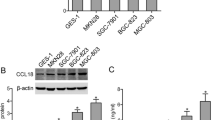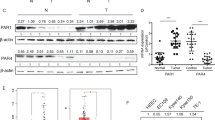Abstract
Our previous study has demonstrated that TF/FVIIa and protease-activated receptor 2 (PAR2) are closely related to the proliferation and migration of colon cancer cell line SW620. However, the detailed signaling cascades and underlying molecular mechanisms remain unclear. This study has investigated whether extracellular signal-regulated kinase 1 and 2 (ERK1/2) and nuclear factor kappaB (NF-κB) signaling pathways are involved in the events. The results revealed that PAR2-activating peptide (PAR2-AP) or FVIIa elicited time-dependent upregulation of ERK1/2 phosphorylation in SW620 cells, and the effect of FVIIa was significantly attenuated by anti-TF antibody. PAR2-AP or FVIIa also increased NF-κB (p65/RelA) levels among cell nuclear proteins and simultaneously decreased IκB-α levels in the cytoplasmic proteins. Such effects of FVIIa can be inhibited with anti-PAR2 or anti-TF antibodies. While ERK1/2 inhibitor (U0126) intervened with the regulatory effects of PAR2-AP and FVIIa on IκB-α/NF-κB (p65/Rel) expression in the cells, NF-κB inhibitor (PDTC) partially blocked the enhancing effects of PAR2-AP and FVIIa on the proliferating and migratory ability of SW620 cells. Furthermore, the regulatory effects of PAR2-AP and FVIIa on expressions of certain proteins (IL-8, caspase-7, and TF) were also significantly abolished by PDTC. Collectively, the data in this study suggest that the interaction between FVIIa and TF induces PAR2 activation, thereby triggers the ERK1/2 and IκB-α/NF-κB signal transduction pathway to regulate the gene expression of IL-8, TF, and caspase-7, and ultimately promotes SW620 cell proliferation and migration.







Similar content being viewed by others

References
Mackman N, Tilley RE, Key NS. Role of the extrinsic pathway of blood coagulation in hemostasis and thrombosis. Arterioscler Thromb Vasc Biol. 2007;27:1687–93.
Schaffner F, Ruf W. Tissue factor and PAR2 signaling in the tumor microenvironment. Arterioscler Thromb Vasc Biol. 2009;29:1999–2004.
Hjortoe GM, Petersen LC, Albrektsen T, Sorensen BB, Norby PL, Mandal SK, et al. Tissue factor-factor VIIa-specific up-regulation of IL-8 expression in MDA-MB-231 cells is mediated by PAR-2 and results in increased cell migration. Blood. 2004;103:3029–37.
Rao LV, Pendurthi UR. Tissue factor–factor VIIa signaling. Arterioscler Thromb Vasc Biol. 2005;25:47–56.
Macfarlane SR, Seatter MJ, Kanke T, Hunter GD, Plevin R. Proteinase activated receptors. Pharmacol Rev. 2001;53:245–82.
Kirkland JG, Cottrell GS, Bunnett NW, Corvera CU. Agonists of protease- activated receptors 1 and 2 stimulate electrolyte secretion from mouse gallbladder. Am J Physiol Gastrointest Liver Physiol. 2007;293:G335–46.
Zhou H, Hu H, Shi W, Ling S, Wang T, Wang H. The expression and the functional roles of tissue factor and protease-activated receptor-2 on SW620 cells. Oncol Rep. 2008;20:1069–76.
Zhou H, Shi W, Zhou B, Guo D, Wang T. Tissue factor-factor VIIa regulates interleukin-8, tissue factor and caspase-7 expression in SW620 cells through protease-activated receptor-2 activation. Mol Med Rep. 2010;3:269–74.
Adam E, Hansen KK, Astudillo Fernandez O, Coulon L, Bex F, Duhant X, et al. The house dust mite allergen Der p 1, unlike Derp 3, stimulates the expression of interleukin-8 in human airway epithelial cells via a proteinase-activatereceptor-2-independent mechanism. J Biol Chem. 2006;281:6910–23.
Chang CJ, Hsu LA, Ko YH, Chen PL, Chuang YT, Lin CY, et al. Thrombin regulates matrix metalloproteinase-9 expression in human monocytes. Biochem Biophys Res Commun. 2009;385:241–6.
Park GH, Jeon SJ, Ryu JR, Choi MS, Han SH, Yang SI, et al. Essential role of mitogen-activated protein kinase pathways in protease activated receptor 2-mediated nitric-oxide production from rat primary astrocytes. Nitric Oxide. 2009;21:110–9.
Syeda F, Grosjean J, Houliston RA, Keogh RJ, Carter TD, Paleolog E, et al. Cyclooxygenase-2 induction and prostacyclin release by protease-activated receptors in endothelial cells require cooperation between mitogen-activated protein kinase and NF-kappaB pathways. J Biol Chem. 2006;281:11792–804.
Roberts PJ, Der CJ. Targeting the Raf-MEK-ERK mitogen-activated protein kinase cascade for the treatment of cancer. Oncogene. 2007;26:3291–310.
Min L, He B, Hui L. Mitogen-activated protein kinases in hepatocellular carcinoma development. Semin Cancer Biol. 2011;21:10–20.
Lawrence MC, Jivan A, Shao C, Duan L, Goad D, Zaganjor E. The roles of MAPKs in disease. Cell Res. 2008;18:436–42.
Yoon S, Seger R. The extracellular signal-regulated kinase: multiple substrates regulate diverse cellular functions. Growth Factors. 2006;24:21–44.
Wang S, Liu Z, Wang L, Zhang X. NF-kappa B signaling pathway, inflammation and colorectal cancer. Cell Mol Immunol. 2009;6:327–34.
Caamano J, Hunter CA. NF-kappaB family of transcription factors: central regulators of innate and adaptive immune functions. Clin Microbiol Rev. 2002;15:414–29.
Bonizzi G, Karin M. The two NF-kappa B activation path ways and their role in innate and adaptive immunity. Trends Immunol. 2004;25:280–8.
Sun SC, Ley SC. New insights into NF-κB regulation and function. Trends Immunol. 2008;29:469–78.
Yang TT, Xue TY, Xu W. Reversal effect of nuclear factor-κB protease inhibitor PDTC on multidrug resistance of K562/AO cells and its mechanism. Zhongguo Shi Yan Xue Ye Xue Za Zhi. 2010;18:903–8.
Mackman N. The many faces of tissue factor. J Thromb Haemost. 2009;7:136–9.
Petersen LC, Freskgård P, Ezban M. Tissue factor-dependent factor VIIa signaling. Trends Cardiovasc Med. 2000;10:47–52.
Poon RT, Lau CP, Ho JW, Yu WC, Fan ST, Wong J. Tissue factor expression correlates with tumor angiogenesis and invasiveness in human hepatocellular carcinoma. Clin Cancer Res. 2003;9:5339–45.
Lindholm PF, Lu Y, Adley BP, Vladislav T, Jovanovic B, et al. Role of monocyte-lineage cells in prostate cancer cell invasion and tissue factor expression. Prostate. 2010;70:1672–82.
Ueno T, Toi M, Koike M, Nakamura S, Tominaga T. Tissue factor expression in breast cancer tissues: its correlation with prognosis and plasma concentration. Br J Cancer. 2000;83:164–70.
Jahan I, Fujimoto J, Alam SM, Sato E, Sakaguchi H, Tamaya T. Role of protease activated receptor-2 in tumor advancement of ovarian cancers. Ann Oncol. 2007;18:1506–12.
Albrektsen T, Sørensen BB, Hjortø GM, Fleckner J, Rao LV, Petersen LC. Transcriptional program induced by factor VIIa-tissue factor, PAR1 and PAR2 in MDA-MB-231 cells. J Thromb Haemost. 2007;5:1588–97.
Versteeg HH, Spek CA, Richel DJ, Peppelenbosch MP. Coagulation factors VIIa and Xa inhibit apoptosis and anoikis. Oncogene. 2004;23:410–7.
Gessler F, Voss V, Dutzmann S, Seifert V, Gerlach R, Kogel D. Inhibition of tissue factor/protease-activated receptor-2 signaling limits proliferation, migration and invasion of malignant glioma cells. Neuroscience. 2010;165:1312–22.
Huang F, Xiong X, Wang H, You S, Zeng H. Leptin-induced vascular smooth muscle cell proliferation via regulating cell cycle, activating ERK1/2 and NF-kappaB. Acta Biochim Biophys Sin (Shanghai). 2010;42:325–31.
Jost PJ, Ruland J. Aberrant NF-kappaB signaling in lymphoma: mechanisms, consequences, and therapeutic implications. Blood. 2007;109:2700–7.
Yao C, Lin Y, Chua MS, Ye CS, Bi J, Li W, et al. Interleukin-8 modulates growth and invasiveness of estrogen receptor-negative breast cancer cells. Int J Cancer. 2007;121:1949–57.
Lakhani SA, Masud A, Kuida K, Porter Jr GA, Booth CJ, Mehal WZ, et al. Caspases 3 and 7: key mediators of mitochondrial events of apoptosis. Science. 2006;311:847–51.
Ledgerwood EC, Morison IM. Targeting the apoptosome for cancer therapy. Clin Cancer Res. 2009;15:420–4.
Acknowledgments
This work was supported by grants of Natural Science Foundation of Jiangsu Province, China (no. BK2010336) to Ying Wu and Sci-tech Innovation Team of Jiangsu University (no. 2008-018-02) to Hong Zhou.
Conflicts of interest
None
Author information
Authors and Affiliations
Corresponding author
Rights and permissions
About this article
Cite this article
Guo, D., Zhou, H., Wu, Y. et al. Involvement of ERK1/2/NF-κB signal transduction pathway in TF/FVIIa/PAR2-induced proliferation and migration of colon cancer cell SW620. Tumor Biol. 32, 921–930 (2011). https://doi.org/10.1007/s13277-011-0194-1
Received:
Accepted:
Published:
Issue Date:
DOI: https://doi.org/10.1007/s13277-011-0194-1



